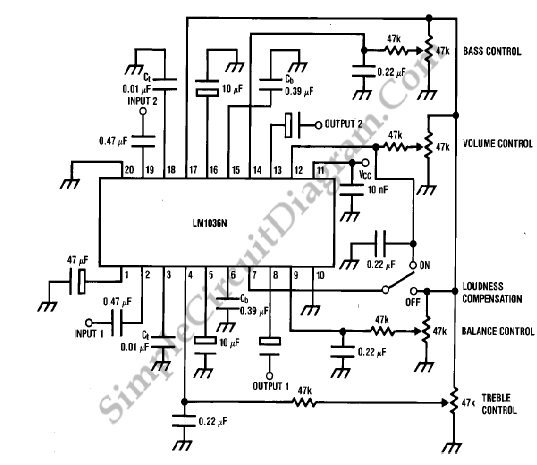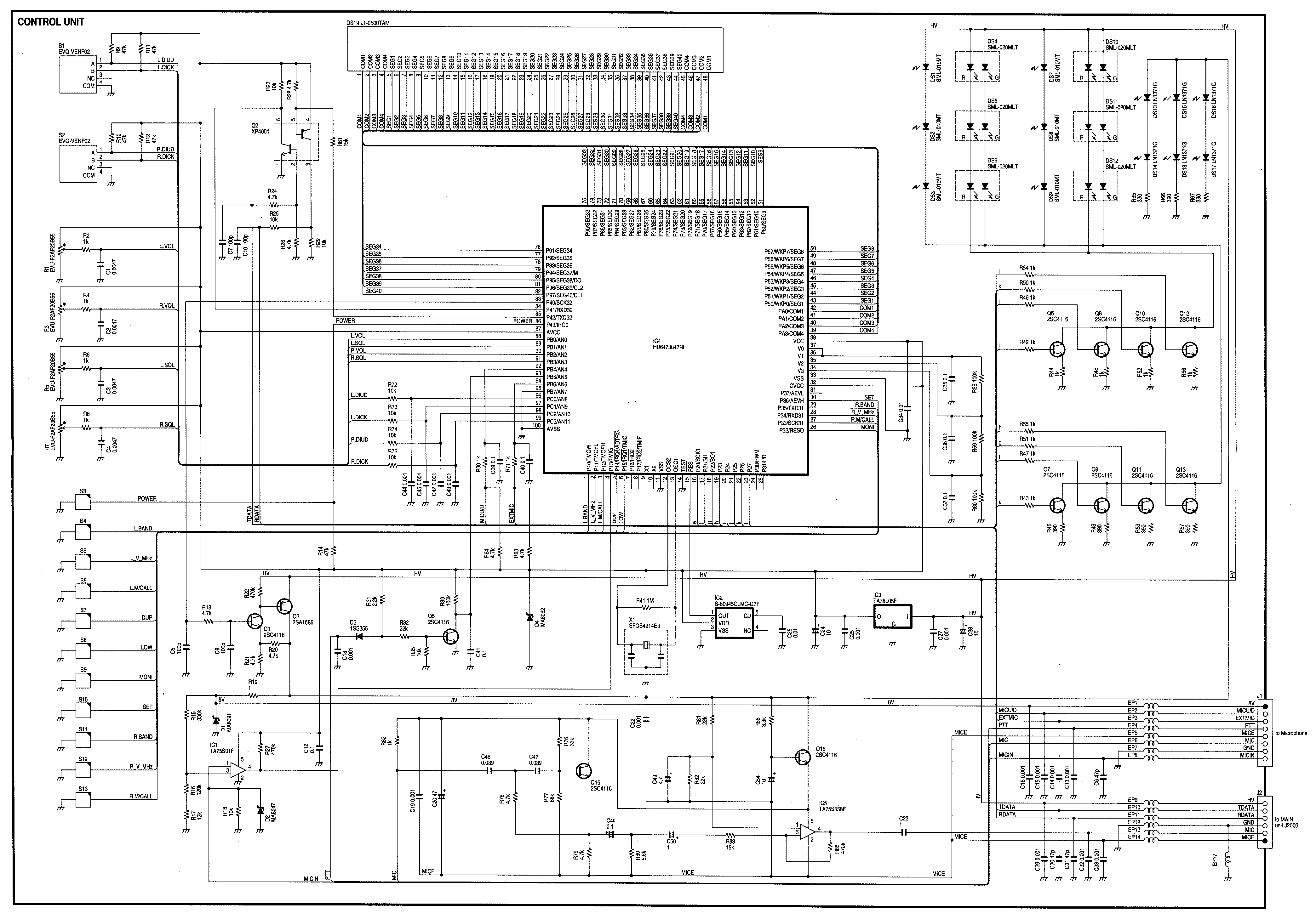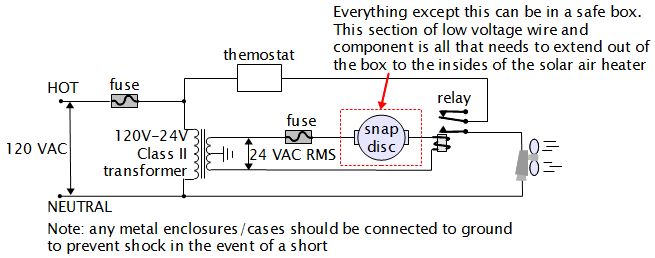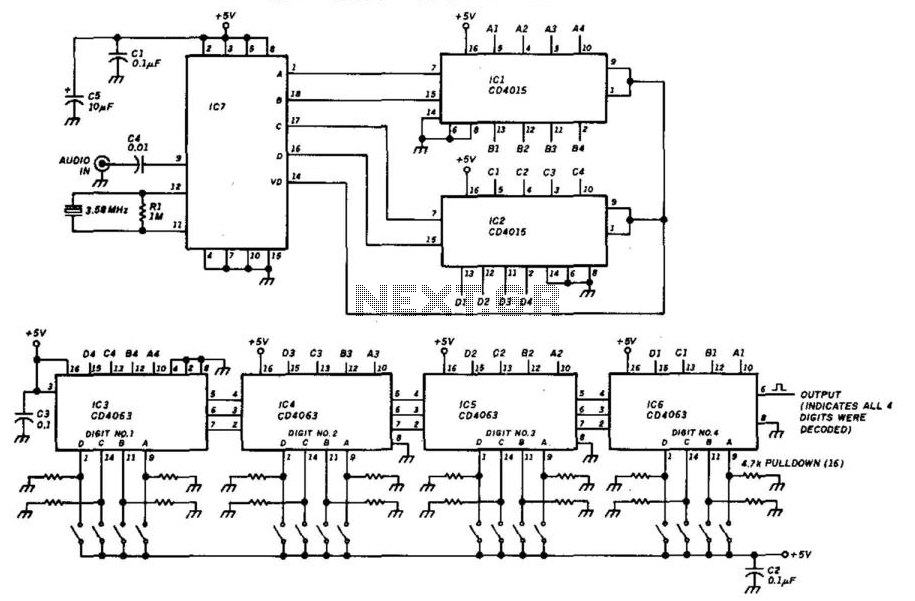
Stereo preamplifier with tone control

The circuit diagram presents a high-quality stereo preamplifier featuring tone control, utilizing the TDA1524 IC from Philips. This integrated circuit requires minimal external components, operates with low noise, and accommodates a broad power supply voltage range. Potentiometers R1 through R4 are designated for adjusting volume, balance, bass, and treble, respectively. The LED, labeled D1, serves as a power-on indicator, with R10 functioning as its current-limiting resistor. The circuit is noted for its excellent performance, and there is an interest in constructing it. However, the balance control potentiometer is to be omitted, with a clarification sought regarding the role of a 100nF capacitor. The circuit has previously been assembled successfully in the early 1990s, demonstrating high quality and control range when paired with a Philips application 40-watt circuit. It is designed for single supply operation, making it compatible with single supply power amplifiers. It is advised against using dual supply power amplifiers, as they may introduce significant distortion in the reproduced sound.
The TDA1524 is a versatile audio amplifier IC that provides a compact solution for stereo preamplification with tone control capabilities. The circuit primarily consists of the TDA1524 IC, several passive components, and the necessary potentiometers for user-controlled adjustments. The inclusion of potentiometers allows for tailored audio output, enhancing user experience through adjustable parameters such as volume and tonal balance.
In the proposed configuration, potentiometers R1 (volume), R2 (balance), R3 (bass), and R4 (treble) interface with the audio signal path. For those opting to eliminate the balance control (R2), the input and output connections can be made directly, effectively bypassing the potentiometer. The 100nF capacitor, which may cause confusion, typically serves as a coupling capacitor, ensuring DC blocking while allowing AC audio signals to pass through. When omitting the balance control, it is essential to maintain the integrity of the signal path, which may involve placing the capacitor in series with the direct connection to avoid any unintended frequency response alterations.
The design's compatibility with single supply power amplifiers is a notable advantage, as it simplifies the power supply requirements and enhances the circuit's versatility. It is crucial to adhere to the manufacturer's guidelines regarding power supply voltage to ensure optimal performance and prevent distortion. The recommendation against using dual supply amplifiers stems from the potential for increased distortion, which can compromise sound quality.
Overall, the TDA1524-based preamplifier circuit represents a robust solution for audio applications, providing essential features while maintaining a straightforward design that is easily modifiable to suit specific needs.Here is the circuit diagram of an excellent stereo preamplifier with tone control using the IC TDA1524 from Phillips. The IC requires very few external components, has very low noise and has a wide power supply voltage range.
POTs R1 to R4 can be used for controlling the volume, balance, bass and treble respectively. LED is D1 is a power ON indica tor and R1o is its current limiting resistor. This is a good circuit. And i want to make this. But i don`t want the balance control. So how can i avoid that pot. I know that all i have to connect the in and out without the pot, but the 100nF cap is confusing me. Hi Anil I have assembled this way back in early 90s a nice circuit with very good quality and control range, with Philips application 40 watt circuit. This circuit is with single supply, hence you can use with single supply power amplifier. motional feed back amplifier is most suited for this chip. Do not try to use this dual supply power amplifiers you will end up with heavy distortion of reproduced sound.
🔗 External reference
The TDA1524 is a versatile audio amplifier IC that provides a compact solution for stereo preamplification with tone control capabilities. The circuit primarily consists of the TDA1524 IC, several passive components, and the necessary potentiometers for user-controlled adjustments. The inclusion of potentiometers allows for tailored audio output, enhancing user experience through adjustable parameters such as volume and tonal balance.
In the proposed configuration, potentiometers R1 (volume), R2 (balance), R3 (bass), and R4 (treble) interface with the audio signal path. For those opting to eliminate the balance control (R2), the input and output connections can be made directly, effectively bypassing the potentiometer. The 100nF capacitor, which may cause confusion, typically serves as a coupling capacitor, ensuring DC blocking while allowing AC audio signals to pass through. When omitting the balance control, it is essential to maintain the integrity of the signal path, which may involve placing the capacitor in series with the direct connection to avoid any unintended frequency response alterations.
The design's compatibility with single supply power amplifiers is a notable advantage, as it simplifies the power supply requirements and enhances the circuit's versatility. It is crucial to adhere to the manufacturer's guidelines regarding power supply voltage to ensure optimal performance and prevent distortion. The recommendation against using dual supply amplifiers stems from the potential for increased distortion, which can compromise sound quality.
Overall, the TDA1524-based preamplifier circuit represents a robust solution for audio applications, providing essential features while maintaining a straightforward design that is easily modifiable to suit specific needs.Here is the circuit diagram of an excellent stereo preamplifier with tone control using the IC TDA1524 from Phillips. The IC requires very few external components, has very low noise and has a wide power supply voltage range.
POTs R1 to R4 can be used for controlling the volume, balance, bass and treble respectively. LED is D1 is a power ON indica tor and R1o is its current limiting resistor. This is a good circuit. And i want to make this. But i don`t want the balance control. So how can i avoid that pot. I know that all i have to connect the in and out without the pot, but the 100nF cap is confusing me. Hi Anil I have assembled this way back in early 90s a nice circuit with very good quality and control range, with Philips application 40 watt circuit. This circuit is with single supply, hence you can use with single supply power amplifier. motional feed back amplifier is most suited for this chip. Do not try to use this dual supply power amplifiers you will end up with heavy distortion of reproduced sound.
🔗 External reference





